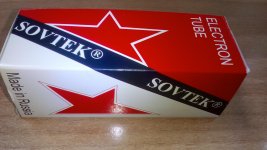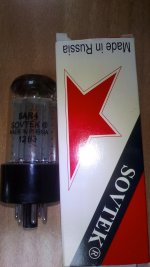How is your build doing tonally after it has seen some use? Any changes?I don't really know. I think the way Salas did it with the tube rectifier and HV regs is probably the way to go. I only did it different because I wanted to keep it as simple as possible.
How is your build doing tonally after it has seen some use? Any changes?
It's still breaking in for sure. It's got about 25-30 hours on it now. Each night I've been swapping in and out different 6V6's and different rectifiers.
So far my hands down favorite is an old (but tests great) 5Y3GT that brings the voltage down to 307 and an old matched pair of chrome top 6V6's. The sound is so sweet, open and airy and just has this lush velvety sound, I just love it with the 45 amp.
I tried that same rectifier with the new Tung Sol 6V6's and didn't like it at all. With a new 5Y3GT that puts the voltage at 336 the new Tung Sol's sound fantastic, It has more the modern tube amp sound, Very clean and has the drive and punch, with all the high's and low's you could want.
I'm also playing around with the 5U4G and 5U4GB that is putting the voltage around 326 but they seem sluggish compared to the 5Y3GT's
With the resister in the power supply I can get as much as 390's so I have a lot of room to play with the voltages.
Don't forget to correctly fuse the transformer's primary. At end of life the rectifier tube might fail with a lightning and a short. At least my previous 5AR4 did but I was also pushing its kickstarter peak current.
The non-DHT tube rectifiers are a bit sensitive to hot starting, like shut on and off and on again due to very little current limiting in the hot cathode, especially with many uF in first C. What you see then is an arc of death.
Stago the first cap it will be 16uf+1K+16uf.
Should be well within spec. Also a little carefulness with toroids, as Rt is low. Imp values for Psud results also, differs alot when playing around.
Thanks Stago its my first attempt with tubes I don't know nothing about tubes...I'm trying to learn on this project...
I don't use toroid trafo .. I will use classic trafo from local store and the specs about Raa of HV windings I don't know if matched to tube rectifier specs .
Sorry for my bad English language...
I don't use toroid trafo .. I will use classic trafo from local store and the specs about Raa of HV windings I don't know if matched to tube rectifier specs .
Sorry for my bad English language...
It seems to me that you are learning quick and your english is surely better then mine so.
Well vacuum rectifiers were designed in the pre-toroid times and EI core transformers needs more wire turns to not saturate. Thus the wire resistance is way smaller and the power-on gets more bangy with toroids. A small resistor in each toroid secondary ending sometimes doesnt hurt.
But you are fine as it seems.
Well vacuum rectifiers were designed in the pre-toroid times and EI core transformers needs more wire turns to not saturate. Thus the wire resistance is way smaller and the power-on gets more bangy with toroids. A small resistor in each toroid secondary ending sometimes doesnt hurt.
But you are fine as it seems.
Usually it's a slow blow rated at nominal primary current for Tx full VA. Local in circuit fuses can be also used where there is special concern. Mostly fast ones rated at a component to protect max current regarding its installed dissipation capability.
I found this .... i think its correct... for my trafo 180VA = about fuse 1-1.2A minimum..
Min. mains side fuse rating (in front of the mains transformer) =
[Transformer VA] / [AC mains voltage] * ( 1 / ( 1 - 2 * (1 - [transformer efficiency %] / 100 )))
IE 30/115*(1/(1-2*(1-84.8/100)))=0.34781259A according to IEC standard for your Avel Lindberg type
(increase fuse rating by factor 1.33 if fuse is designed according to UL standard for continuously operating at 75% of rated current of the fuse).
Rough approximation is transformer VA / VAC mains * [1.3 ... 1.6], depending on efficiency.
Last edited:
salas, i don't see any cathode follwer in your circuit. Your circuit seems like a direct plate output without any use of cathode follower.
Would a premium quality line output transformer (amorphous wound with single crystal copper) improve the transparency?
Thanks!
Would a premium quality line output transformer (amorphous wound with single crystal copper) improve the transparency?
Thanks!
Sorry typo. What I want to ask whether amplifier with high sensitivity (0.5v full power) adequate for this 6V6 linestage with output transformer (10K)?
I prefer SSHV2 as I have it on hand. However, what I concern whether the 20H choke still necessary when good reg like the SSHV2 is in the rail?
Yes, I agree if the input impedance of amp has pretty high impedance, then cap coupling is the way to go. I have friend build a preamplifier with cathode follower to drive the Quad II amplifier that has 1.5M input impedance and has a great result!!
i don't see any cathode follwer in your circuit. Your circuit seems like a direct plate output without any use of cathode follower.
Yes. That's the whole point of using the 6V6 power tube. It has a low enough plate resistance and current capability to be used directly.
Yes. That's the whole point of using the 6V6 power tube. It has a low enough plate resistance and current capability to be used directly.
What is the output impedance of this Salas 6V6 linestage circuit?
- Home
- Amplifiers
- Tubes / Valves
- 6V6 line preamp

